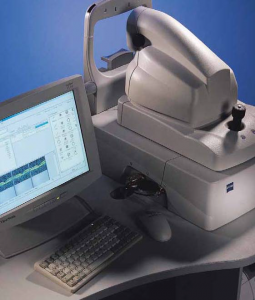June 11, 2013
Glaucoma, Diabetes and Macular Degeneration
Three of the most common eye diseases are glaucoma, macular degeneration and diabetes. Vision Center PC has the knowledge and technology to detect symptoms of these diseases, providing guidance to minimize vision damage.
Glaucoma
The key to preventing vision loss is early glaucoma detection. Vision Center PC is able to diagnose the blinding  disease at its earliest stage with the Optica Coherence Tomography (OCT) – often before any vision is lost.
disease at its earliest stage with the Optica Coherence Tomography (OCT) – often before any vision is lost.
The OCT creates high resolution cross-sectional images of the back of the eye, similar to an MRI. It allows your eye doctor to view the nine different layers of the retina to detect early signs of damage from glaucoma, macular degeneration and diabetic retinopathy. In most cases, the measurements take less than a minute and dilation is usually not required. This technology will allow the doctors at the Vision Center PC detect eye disease much earlier, before significant vision loss has occurred.
Diabetes
Diabetes mellitus is a group of diseases characterized by high levels of blood glucose resulting from defects in insulin production, insulin action, or both. Diabetes can be associated with serious complications and premature death, but people with diabetes can take steps to control the disease and lower the risk of complications. Total
prevalence of diabetes in the U.S. is over 18 million. If you are overweight, or have a family history of diabetes, you may be at risk. Many people have the disease for years before it is diagnosed.
Those who have diabetes are at risk for damage to the eye, called diabetic retinopathy. This occurs when the small blood vessels inside the eye become leaky from the insult of high blood sugar levels. This leakage can cause permanent visual loss.
If you have diabetes, the American Medical Association and the American Optometric Association recommend a dilated eye exam annually.
Macular Degeneration
 Age related macular degeneration is the leading cause of visual impairment and blindness in the US. AMD, (age-
Age related macular degeneration is the leading cause of visual impairment and blindness in the US. AMD, (age-
related macular degeneration) is a serious disease that my result in loss of central vision. The exact cause is not known, but the risk factors include: older age (over 60), family history, Caucasian, smoking, obesity, heart disease and hypertension.
AMD affects the back of your eye, the retina. It damages your central vision making it difficult to drive or read small print. People do not go totally blind since they still retain good peripheral vision. There are two types: dry and wet. Ninety percent develop the milder “dry” form and this may occur gradually over time. Ten percent of AMD cases are “wet” which means the tissue in the retina has degenerated enough that blood or fluid begins to seep through the cracks. New blood vessels may begin to grow. This may lead to permanent scarring and central visual loss.
Treatments for the dry type include observation and some studies have shown some benefits from certain vitamin supplements. The severe wet form may benefit from certain types of laser surgery and new injectable drugs that can lead to less scar formation. Treatments may not restore lost vision in some cases, but can help the eye
from getting worse.
Preventative therapy is the key. Remember these key suggestions: Don’t smoke, or stop immediately, maintain normal blood pressure, get regular exercise and watch your weight. Doctors recommend wearing sunglasses and eating a healthy diet that includes green leafy vegetables and fish. Ask your optometrist about vitamin supplements.
